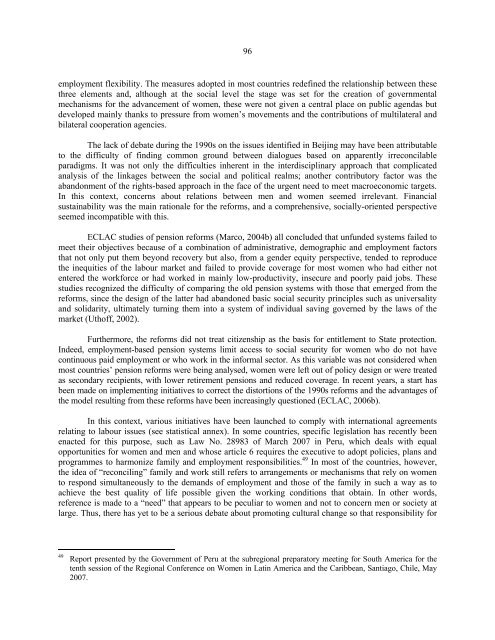Women in Latin America and the Caribbean - Cepal
Women in Latin America and the Caribbean - Cepal
Women in Latin America and the Caribbean - Cepal
You also want an ePaper? Increase the reach of your titles
YUMPU automatically turns print PDFs into web optimized ePapers that Google loves.
96<br />
employment flexibility. The measures adopted <strong>in</strong> most countries redef<strong>in</strong>ed <strong>the</strong> relationship between <strong>the</strong>se<br />
three elements <strong>and</strong>, although at <strong>the</strong> social level <strong>the</strong> stage was set for <strong>the</strong> creation of governmental<br />
mechanisms for <strong>the</strong> advancement of women, <strong>the</strong>se were not given a central place on public agendas but<br />
developed ma<strong>in</strong>ly thanks to pressure from women’s movements <strong>and</strong> <strong>the</strong> contributions of multilateral <strong>and</strong><br />
bilateral cooperation agencies.<br />
The lack of debate dur<strong>in</strong>g <strong>the</strong> 1990s on <strong>the</strong> issues identified <strong>in</strong> Beij<strong>in</strong>g may have been attributable<br />
to <strong>the</strong> difficulty of f<strong>in</strong>d<strong>in</strong>g common ground between dialogues based on apparently irreconcilable<br />
paradigms. It was not only <strong>the</strong> difficulties <strong>in</strong>herent <strong>in</strong> <strong>the</strong> <strong>in</strong>terdiscipl<strong>in</strong>ary approach that complicated<br />
analysis of <strong>the</strong> l<strong>in</strong>kages between <strong>the</strong> social <strong>and</strong> political realms; ano<strong>the</strong>r contributory factor was <strong>the</strong><br />
ab<strong>and</strong>onment of <strong>the</strong> rights-based approach <strong>in</strong> <strong>the</strong> face of <strong>the</strong> urgent need to meet macroeconomic targets.<br />
In this context, concerns about relations between men <strong>and</strong> women seemed irrelevant. F<strong>in</strong>ancial<br />
susta<strong>in</strong>ability was <strong>the</strong> ma<strong>in</strong> rationale for <strong>the</strong> reforms, <strong>and</strong> a comprehensive, socially-oriented perspective<br />
seemed <strong>in</strong>compatible with this.<br />
ECLAC studies of pension reforms (Marco, 2004b) all concluded that unfunded systems failed to<br />
meet <strong>the</strong>ir objectives because of a comb<strong>in</strong>ation of adm<strong>in</strong>istrative, demographic <strong>and</strong> employment factors<br />
that not only put <strong>the</strong>m beyond recovery but also, from a gender equity perspective, tended to reproduce<br />
<strong>the</strong> <strong>in</strong>equities of <strong>the</strong> labour market <strong>and</strong> failed to provide coverage for most women who had ei<strong>the</strong>r not<br />
entered <strong>the</strong> workforce or had worked <strong>in</strong> ma<strong>in</strong>ly low-productivity, <strong>in</strong>secure <strong>and</strong> poorly paid jobs. These<br />
studies recognized <strong>the</strong> difficulty of compar<strong>in</strong>g <strong>the</strong> old pension systems with those that emerged from <strong>the</strong><br />
reforms, s<strong>in</strong>ce <strong>the</strong> design of <strong>the</strong> latter had ab<strong>and</strong>oned basic social security pr<strong>in</strong>ciples such as universality<br />
<strong>and</strong> solidarity, ultimately turn<strong>in</strong>g <strong>the</strong>m <strong>in</strong>to a system of <strong>in</strong>dividual sav<strong>in</strong>g governed by <strong>the</strong> laws of <strong>the</strong><br />
market (Uthoff, 2002).<br />
Fur<strong>the</strong>rmore, <strong>the</strong> reforms did not treat citizenship as <strong>the</strong> basis for entitlement to State protection.<br />
Indeed, employment-based pension systems limit access to social security for women who do not have<br />
cont<strong>in</strong>uous paid employment or who work <strong>in</strong> <strong>the</strong> <strong>in</strong>formal sector. As this variable was not considered when<br />
most countries’ pension reforms were be<strong>in</strong>g analysed, women were left out of policy design or were treated<br />
as secondary recipients, with lower retirement pensions <strong>and</strong> reduced coverage. In recent years, a start has<br />
been made on implement<strong>in</strong>g <strong>in</strong>itiatives to correct <strong>the</strong> distortions of <strong>the</strong> 1990s reforms <strong>and</strong> <strong>the</strong> advantages of<br />
<strong>the</strong> model result<strong>in</strong>g from <strong>the</strong>se reforms have been <strong>in</strong>creas<strong>in</strong>gly questioned (ECLAC, 2006b).<br />
In this context, various <strong>in</strong>itiatives have been launched to comply with <strong>in</strong>ternational agreements<br />
relat<strong>in</strong>g to labour issues (see statistical annex). In some countries, specific legislation has recently been<br />
enacted for this purpose, such as Law No. 28983 of March 2007 <strong>in</strong> Peru, which deals with equal<br />
opportunities for women <strong>and</strong> men <strong>and</strong> whose article 6 requires <strong>the</strong> executive to adopt policies, plans <strong>and</strong><br />
programmes to harmonize family <strong>and</strong> employment responsibilities. 49 In most of <strong>the</strong> countries, however,<br />
<strong>the</strong> idea of “reconcil<strong>in</strong>g” family <strong>and</strong> work still refers to arrangements or mechanisms that rely on women<br />
to respond simultaneously to <strong>the</strong> dem<strong>and</strong>s of employment <strong>and</strong> those of <strong>the</strong> family <strong>in</strong> such a way as to<br />
achieve <strong>the</strong> best quality of life possible given <strong>the</strong> work<strong>in</strong>g conditions that obta<strong>in</strong>. In o<strong>the</strong>r words,<br />
reference is made to a “need” that appears to be peculiar to women <strong>and</strong> not to concern men or society at<br />
large. Thus, <strong>the</strong>re has yet to be a serious debate about promot<strong>in</strong>g cultural change so that responsibility for<br />
49<br />
Report presented by <strong>the</strong> Government of Peru at <strong>the</strong> subregional preparatory meet<strong>in</strong>g for South <strong>America</strong> for <strong>the</strong><br />
tenth session of <strong>the</strong> Regional Conference on <strong>Women</strong> <strong>in</strong> Lat<strong>in</strong> <strong>America</strong> <strong>and</strong> <strong>the</strong> <strong>Caribbean</strong>, Santiago, Chile, May<br />
2007.











